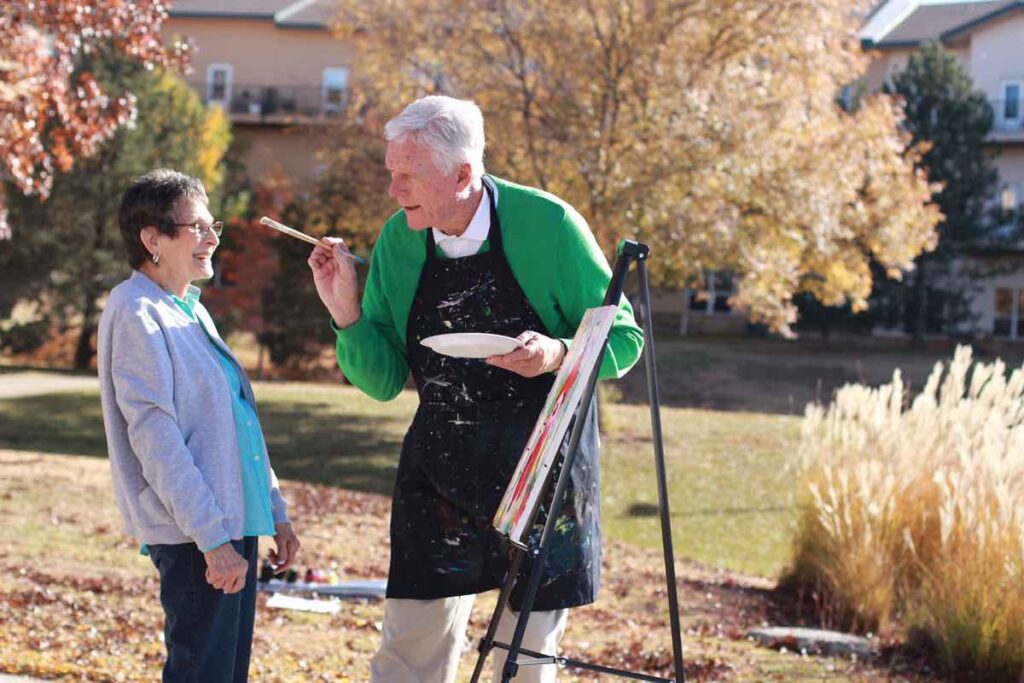
Time with Granddad
“I just want our time together to mean something,” pleaded Kelsie. Because Kelsie was her grandparents’ only grandchild, she and her grandfather, Bart, had always been close, particularly after her grandmother passed away. But as Bart’s dementia has progressively worsened, Kelsie feels like she’s losing him, too.
In spite of the excellent care, socialization, and memory stimulation Bart is receiving in the Memory Care Wing of his Life Plan Community, his dementia is becoming more and more noticeable to Kelsie and her mother, Bart’s daughter. The frustration has created an emotional strain on them since they feel like they have little enough time with Bart—and they want to make every moment count.
Fortunately, the specially trained memory care staff are experts at educating and guiding residents’ family members—and know how to help these untrained family members improve their connections with loved ones.
A Familiar Community of Support
Bonnie is one of the Dementia and Alzheimer’s Care Specialists at Maple View, the Memory Care area of the Assisted Living section of Bart’s Life Plan Community. After Kelsie’s grandmother passed away, Kelsie and her mom offered to have Bart come live with them. But Bart appreciated the Respite Care his wife had received at the Life Plan Community, and he already had friends in the Independent Living apartment homes on campus, which he decided was the right place for him.
Because Bart was already living on campus, his transition to Memory Care was simple to arrange when it became necessary. The fact that the campus was familiar to him facilitated his moves, first to Assisted Living from Independent Living, then to Maple View Memory Care and helped him stay calm. In addition, he was able to keep his cardiologist and other specialists because all levels of care are offered at his community. A known environment and familiar, friendly faces set Bart up to have the best experience possible at Maple View.
What to Expect
Knowing what to expect can help us prepare for time with loved ones coping with dementia. According to the Mayo Clinic, these are the conversational patterns our loved ones will likely follow:
- Having trouble finding the right word
- Substituting words
- Describing an object rather than naming it
- Repeating words, stories, or questions
- Mixing unrelated ideas or phrases together
- Losing a train of thought
- Speaking less frequently
- Reverting to a first language
Good Communications Skills
Bonnie explained to Kelsie and her mom that connecting with Bart means building on existing good communications skills. She gave these example that would apply to any conversation:
- Avoid distractions, such as TV, radio, and cell phones
- Make eye contact
- Focus on the person you’re with
- Listen for conversation cues
- Watch for nonverbal cues
Building on a Solid Foundation
Because of Bart’s dementia, Bonnie continued, we can build on our foundation of good communication skills to help us better connect with Bart:
- Be patient
- Look for context clues, such as gestures or facial expressions
- Stay calm, keeping your speaking voice low
- Hold hands if that is welcomed
- Exercise empathy and compassion; let your loved one know you appreciate their struggle to connect with you
- Speak in simple sentences that might elicit yes/no answers
- Keep your tone and word choice respectful; don’t use a high-pitched register or “baby talk”
- Use environmental cues and visuals (pointing, leading your loved one to the window or sharing a picture) when possible
Bonnie stressed, too, that there’s nothing wrong with taking a break: it’s better to graciously step away than get frustrated. Your loved one will be able to pick up on your frustration through your tone and body language, so take as many breaks as needed.
Better Connections
“Now I know what to expect—and that this is Granddad’s new normal,” explains Kelsie. And, she adds, she’s starting to learn his “language” and way of communicating with her. She feels better able to connect with him, and is improving her skills as she gains more confidence about spending time with him. They take walks around the courtyard garden and do arts and crafts together in the memory room. Kelsie’s mom suggested bringing a photo to every visit, and Bonnie continues to share tips and ideas, helping Kelsie make memories with her beloved grandfather.
